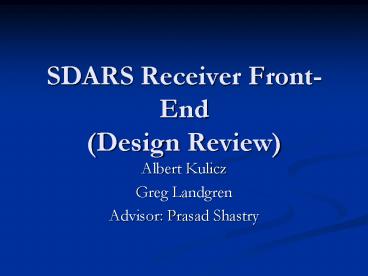SDARS Receiver Front-End (Design Review) PowerPoint PPT Presentation
Title: SDARS Receiver Front-End (Design Review)
1
SDARS Receiver Front-End(Design Review)
- Albert Kulicz
- Greg Landgren
- Advisor Prasad Shastry
2
Outline
- Overview
- Goals
- Tasks for Semester
- Antenna
- LNA Network
- Fabrication
- Tentative Schedule
3
What is SDARS?
- This project involves designs, simulations,
fabrication, and testing of a patch antenna and
low-noise amplifier (LNA) to receive SDARS
signals by means of SIRIUS receiver. - The inclusion of the entire active antenna
(passive antenna impedance matching network
LNA) will be designed to minimize physical size,
while producing the best quality of signal.
4
System Block Diagram
Incoming Circularly Polarized Satellite Signal
(-105 to -95)dbm
5
Antenna Goals
- Receive signals in the frequency band from 2.32
GHz to 2.3325 GHz (BW of 12.5 MHz) - Left Hand Circular Polarization (LHCP)
- Match in impedance to LNA network
- (50 Ohms)
- Probe Feed Placement will determine
polarization and impedance match
6
LNA Goals
- Noise factor shall be lt 1dB
- NF F1 (F2 -1)/G1 (F3-1)/(G1G2 ) . . .
- Total gain shall be -gt 4050 dB
- Gtotal G1 G2 . . .
7
Tasks for Semester
- Complete EM simulations with Momentum and
optimize antenna design (Feb) - Test LNA evaluation boards with NA (Feb)
- Design Impedance Matching for the LNA network
(Feb) - Simulate entire active antenna in Agilent ADS
(March) - Design Bias Circuitry for the LNAs (March)
- Outsource Fabrication of Substrates (April)
- Test Fabricated Antenna and LNA substrates (May)
- Test complete systems active antenna board with
Sirius Receiver (May)
8
3D Passive Antenna Model
9
Antenna Dimension Equations
- (LW for square patch)
- Initial length L c/(2fo er(1/2))
- eeff (er1)/2 (er-1)/2112(h/L))(-1/2)
- Fringe factor, ?L0.412 h (e eff 0.3)( W/h
0.264) / ( (e eff - 0.258)(W/h 0.8)) - New length L c/(2fo eeff(1/2)) - 2?L
- repeat iterative process
3.69cm x 3.69 cm
1 Balanis, Constantine A, Microstrip
Antennas, in Antenna Theory, 3rd ed. John Wiley
and Sons, Inc., 2005, pp. 811-882
10
PCAAD (design for 2.326ghz)
11
EM Simulation / Optimization
Agilent ADS - Patch Antenna S11
12
Patch Antenna Top View
Probe location x 2.6372 cm x y 2.6372 cm
(0.509 cm from center)
13
EM Simulation / Optimization
Agilent ADS - Patch Antenna S11
Impedance Zo(0.978-j0.001)
14
Antenna Dissected Side View
Probe Feed copper wire diameter 0.15 cm Probe
hole 0.165 cm
15
Antenna - Bottom View (LNA network)
16
LNA schematics
17
LNA experimental Gain
- Powered by Sirius Receiver
18
S11 (return loss)
Entire System (Passive Antenna LNA)
19
Fabrication
- Microcircuits, Inc.
- Using Gerber files for both antenna and LNA
layouts - CAMtek, Inc.
- Soldering
20
Tentative Schedule
- Finalize Antenna and LNA layout and send Gerber
file to Microcircuits (Mar.9) - Test fabricated Antenna performance (March)
- Send fabricated LNA substrate to CAMtek for
soldering (March) - Assembly of completed boards, solder probe,
mount to a Plexiglas or plastic encasing (April)
21
Conclusion
- Finalized patch antenna dimensions and probe
location - LNA network gain will not meet proposed goal, but
will suffice for our purposes - Simulations show respectable return loss at
desired bandwidth - Fabrication and Assembly to be completed
22
References
- 1 Zomchek, Greg and Zeliasz, Erik. SDARS
Front-End Receiver Senior Capstone Project - Report. Bradley University, Spring, 2001.
- 2 Lockwood, Kevin. SDARS Front-End Receiver
Senior Capstone Project Report. - Bradley University, Spring, 2011.
- 3 Balanis, Constantine A., Microstrip
Antennas, in Antenna Theory, 3rd ed. John Wiley - and Sons, Inc., 2005, pp.811-882
- 4 Pozar, David M. and Schaubert, Daniel H. A
Review of Bandwidth Enhancement - Techniques for Microstrip Antennas, in
Microstrip Antennas the analysis and design of - microstrip antennas and arrays Institute of
Electrical and Electronics Engineers, Inc., 1995, - pp.157-165

